I’m sure many of you have heard of Mary Kay cosmetics, one of the largest network marketing companies in the world. There are more than 800,000 Mary Kay beauty consultants throughout the world, who have accomplished more than $1.2 billion in sales. The founder of this hugely successful organization was named Mary Kay Ash — Read more
Industry Blogs

I’m sure many of you have heard of Mary Kay cosmetics, one of the largest network marketing companies in the world. There are more than 800,000 Mary Kay beauty consultants throughout the world, who have accomplished more than $1.2 billion in sales. The founder of this hugely successful organization was named Mary Kay Ash — and I am one of the many people who have purchased her products and contributed to those numbers.
Many people have asked Mary Kay what she owed her success to. What was her secret to building an empire and acquiring so much wealth? There are two quotes in response to this question that I want to share with you today. I frequently ponder on them and even have them posted in my house as a reminder of how I should live my life.
- Quote No. 1: “I have learned to imagine a sign hanging from every person’s neck that says, ‘Make me feel important today.’”
- Quote No. 2: “Everyone wants to be appreciated, so if you appreciate someone, don’t keep it a secret.”
Isn’t that an amazing mindset and perspective to have? Imagine if we could all master the art of appreciation in our lives. How different this world would be! It’s not that we would do this to make more money and have more power. Perhaps it would be a natural result as was the case with Mary Kay. But I believe that if we expressed appreciation to those around us on a daily basis and proactively sought out ways to make people feel important, not only would our own lives be enriched, the lives of countless others would also be uplifted and changed for the better. Everything about humanity would be better.

Appreciation is especially vital in the workplace. I have heard many business owners say “Why do I need to reward my employees for doing their job? That’s what I pay them for.” I have also heard “What’s the point of incentives? I shouldn’t have to pay someone to do their job in the first place.” I hope you’re like me and cringed when you read that.
So, let’s break it down: There is a difference between paying your employees to do their job, appreciating them for doing their job, and incentivizing them to take it to the next level. I am going to provide you with some ideas that I hope you will find valuable and helpful in connecting and growing your team.
Paying Employees to do their job
Everyone in your company is going to be all about the WIIFM — what’s in it for me? Your team, no matter how much they love what they do or find purpose in it, will always want to know how much they are compensated for doing their job. Having clear roles and responsibilities is very important so people know what is expected of them in return for a paycheck. But so often employees are given new or different tasks that might be outside of their daily duties. Sometimes people are more than happy to jump in and help, but if they are given a project that backs them up with their normal job and takes them away from their family and having a life, they are going to want to know the WIIFM.
Appreciating employees for doing their job
So, you pay your people to do their job. But appreciating them to do their job is different. It has to be a show and tell. Many business owners and leaders might give shout-outs at company meetings or say things like “I appreciate all you do.” Words of affirmation are great, but they are just words. What are you doing to show your team you value them? Here are some ideas that I’ve seen just within the last year since the pandemic hit:
Since my husband started working from home full-time, his company has sent him a swag box in the mail every single month to say thank you. It would have a new sweater or jacket, Yeti water bottle, Cabala’s gift card (we love that store), gourmet chocolate, journals, flashlights, etc.
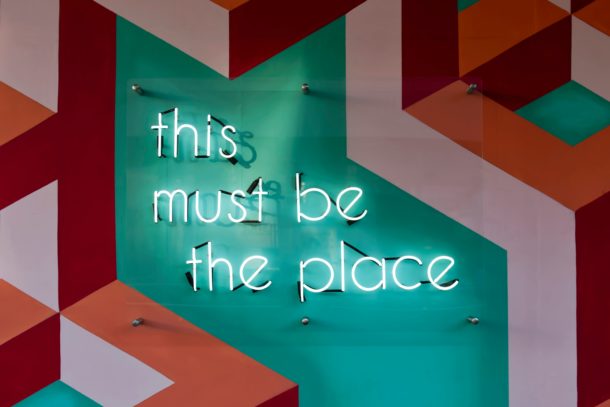
Sarah Hammond, owner of Atlas Plumbing, Air, and Electric, buys each employee a bag of fruits and vegetables every single month to take home to their families. She advocates employee health programs, wellness and wants to support them in this way
Jennifer Bagley, owner of CI Web group, got all of her team members a Peloton exercise bike, and they actually do company workouts together from home.
Ryan Kohler, owner of Hire Dimensions, provides a housecleaner to each one of his employees every month to do the deep cleaning.
These are just some of the ways the leaders are saying thank you to their employees. They are saying thank you with gifts and actions, not just words. Gifts matter.
Incentivizing your team to take it to the next level
Apart from paying your employees to do their job and appreciating them for doing so, motivating them is a whole new ballgame. No matter how much someone loves what they do, they will get burned out. Everyone needs a break to reset every now and then. They also need something to always stay motivated to continue helping you build your empire.
Incentives should be short-term and long-term. You might need a certain task completed by a certain deadline — such as scheduling membership appointments by the end of the month or reaching a specific revenue goal. If you are needing something done fast, creating individual and team incentives is the way to go.
Long-term incentives can also be super beneficial — like at the end of the year if your business reaches a certain level, everyone gets to cash in on the prize. Bonuses, spiffs, and incentives are a great way to keep your team motivated, help them feel appreciated, and provides you opportunities as a leader to keep people engaged in growing your business.
Short-term incentives can come in the form of gift cards, PTO, spiffs, work-from-home day, prize box, lunch, etc. Long-term incentives could come in the form of vacations, (I know a contractor who gives away a cruise for two every month to his employees), large scale and expensive prizes, cash, gym memberships, etc.
Just have fun with it! Find out what your employees want and then help them get it by creating a plan of action to achieve their goals.
I want to encourage everyone, and challenge myself, to find someone each day of our lives who we can make feel important. We always remember the thoughtful things people do for us. Let’s all commit to becoming better at being the person who does thoughtful things for others on a daily basis.
 Erica Leonor is Executive Trainer for Power Selling Pros. As an Executive Trainer at Power Selling Pros, Erica Leonor is constantly developing new content and curriculum that will enable home service businesses to achieve a higher level of success for themselves, their teams, and their customers. A mentor, coach, presenter, and public speaker for over 10 years, Erica also serves on the Board of Directors of Women in HVACR. She received a B.A. in anthropology from BYU-Hawaii.
Erica Leonor is Executive Trainer for Power Selling Pros. As an Executive Trainer at Power Selling Pros, Erica Leonor is constantly developing new content and curriculum that will enable home service businesses to achieve a higher level of success for themselves, their teams, and their customers. A mentor, coach, presenter, and public speaker for over 10 years, Erica also serves on the Board of Directors of Women in HVACR. She received a B.A. in anthropology from BYU-Hawaii.

In March, we celebrate Women’s History Month to honor the heroic and historic accomplishments of women in all areas of accomplishment. In plumbing, we look to Lillian Baumbach, the first female master plumber in the United States. Women, like Lillian, paved the way for modern female plumbers and other tradeswomen. The best form of honor Read more
In March, we celebrate Women’s History Month to honor the heroic and historic accomplishments of women in all areas of accomplishment. In plumbing, we look to Lillian Baumbach, the first female master plumber in the United States. Women, like Lillian, paved the way for modern female plumbers and other tradeswomen. The best form of honor is respect. There is no better way to respect tradeswomen than acting like a true ally.
What is an ally? An ally is an individual, contractor, manufacturer and/or retailer who stands with and for tradeswomen.
Women constitute a mere 1.5% of the construction trades industry workforce. With numbers so low, it’s easy to feel alone and isolated in your work environment. Below, find some tips to being an ally.
An ally:
 Mentors – Providing sage advice to apprentices and young people in the skilled trades helps them feel welcomed in their work environment. This extends to facilitating networking and social events.
Mentors – Providing sage advice to apprentices and young people in the skilled trades helps them feel welcomed in their work environment. This extends to facilitating networking and social events.- Does not assume – When in doubt, ask. Also, do not assume stereotypes about women or women who work in the skilled construction trades. Having low expectations of tradeswomen is another gaffe. Do not assume tradeswomen possess less experience or cannot complete the same tasks as a tradesman.
- Isn’t shy – An ally calls people out and does not tolerate inappropriate and demeaning humor or remarks. Additionally, get involved with women’s committees. Both men and women can support women in the trades. An ally can also get involved with policy. Share information about the Paid Family and Medical Leave Act, sexual harassment training, and pregnancy discrimination.
- Doesn’t mansplain – This should go without saying.
- Encourages all voices – Keep an open mind. As a leader, create environments where all voices can be heard and appreciated.
It’s not simple, but it’s worth it. Allies, like tradeswomen, come in all shapes, sizes, colors, and creeds. An ally is a powerful tool for recruitment and retention of tradeswomen. Rest assured, tradeswomen will still be here with or without allies. But, they help to improve the workplace for all.
 Guest Blogger – Allie Perez founded Texas Women in Trades in 2013, an organization working to bring more women, minorities, and young people to the trades. She also serves as the VP of Marketing and Operations at George Plumbing Co. in San Antonio and on the National Taskforce for Tradeswomen as the Communications Committee Co-Chair. A graduate of New York University, Allie has contributed to trade periodicals for more than seven years. To contact her directly, email texaswomenintrades@gmail.com.
Guest Blogger – Allie Perez founded Texas Women in Trades in 2013, an organization working to bring more women, minorities, and young people to the trades. She also serves as the VP of Marketing and Operations at George Plumbing Co. in San Antonio and on the National Taskforce for Tradeswomen as the Communications Committee Co-Chair. A graduate of New York University, Allie has contributed to trade periodicals for more than seven years. To contact her directly, email texaswomenintrades@gmail.com.
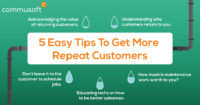
It’s every business’ dream to have as many streams of incoming revenue as possible. New customers generally make the bulk of a plumbing business’ revenue but with diversification on many people’s minds nowadays, perhaps it’s time to take a look at some alternatives. What’s one that immediately comes to mind? Repeat customers, of course! Acknowledging Read more
It’s every business’ dream to have as many streams of incoming revenue as possible. New customers generally make the bulk of a plumbing business’ revenue but with diversification on many people’s minds nowadays, perhaps it’s time to take a look at some alternatives. What’s one that immediately comes to mind? Repeat customers, of course!
Acknowledging the value of returning customers
The first step is acknowledging the actual value of customer loyalty. I’m positive you’ve never thought to yourself “I hate loyal customers”; after all, it’s no doubt a good thing to have people choosing to hire you again and again: wear it like a badge of honor! But just because you’re happy about that, it doesn’t necessarily mean you’re properly appreciating the value that these repeat customers provide your business with.
From a statistical point of view, retaining customers is up to 5 times cheaper than acquiring new ones. Returning customers also spend more: up to 300%! That’s a whole lot of value to be taking more seriously, which means strategizing how you can retain even more customers is important, too.
Equally, it helps to keep things in perspective; your plumbing business might be different, so it’s important to sit down with your own numbers and see if they do, in fact, match up to this potential.
Regardless, thinking up strategies to boost your returning customer rate is never going to hurt: even a little can go a long way. If there’s one thing we’ve learned from 2020 it’s that keeping your eggs in the same basket is not ideal, so having diverse streams of income is always a good idea.
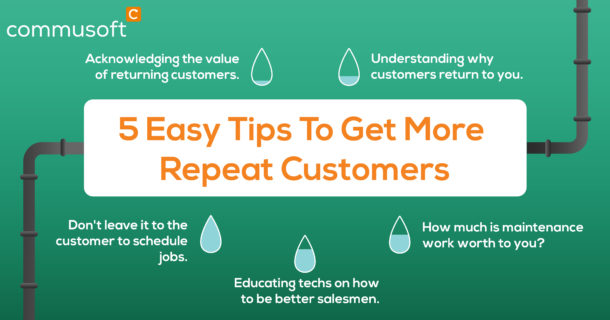
Understanding why customers return to you
“Because I did a great job!” is the most natural answer to this question and oftentimes it’s also the right one. But, with competition in the plumbing industry being what it is nowadays, it’s hubris to say that you’re the only plumber in town who can do a good job.
If we’re going to be honest about it, most customers have a hard time telling an average job from a great one. As long as nothing breaks down for a reasonable number of days and there isn’t a massive mess, they won’t think twice about it.
To push the example, check out your own reviews and those of a competitor, then count how many times “great customer service”, “convenient”, “easy to communicate with” and other such phrases are mentioned. Then compare the number against how often “my hot water booster installation was a work of art” shows up.
It’s not the big things you do, but more often the run-of-the-mill details – like sending email confirmations and having techs wear polo shirts – that often make the biggest impact. Some other tips to get more repeat customers (and positive reviews) would be:
- 24/7 availability with the help of an online booking portal
- Keeping customers in the loop with automatic email/text notifications
- Sharing technician arrival times & tracking info so they’re not taken by surprise
- Training your techs & admin to always be presentable and make a good impression
- Sending feedback requests after the work is done
How much is maintenance work worth to you
Servicing appliances isn’t high up on anyone’s list of favorite jobs. It’s mundane, presents little to no challenge, and doesn’t seem to bring in much profit. The latter isn’t difficult to fix – if you use your net profit per hour to set prices instead of gross margins, every job will be a (highly) profitable job.
Regularly servicing appliances helps ensure that they work properly, don’t use up more electricity than they should, and that they last longer. Not to mention it helps avoid dangerous malfunctions that people might not even be aware of. These are all reasons to inform your customers and sell them on a service deal.
This can even work as a sales strategy, where you offer a “subscription plan”. Instead of charging them, say, $164.99 next year, when you come for the maintenance check, they can pay $13.75/month and have a technician available to them at all times for free check-ups and advice. $13.75/month might sound like change, but rack up 50 of these 30-minute jobs, and you’ve got almost $700/month guaranteed for only 25h of work!
Educating techs on how to be better salesperson
A technician’s priority is to do a great job – that’s always going to be true. But they’re also oftentimes the only face-to-face interaction customers have with your plumbing business. The level of trust they’re afforded shouldn’t be taken for granted, which means that pushy sales techniques and tactics don’t have a place in this situation. This being said, a technician can always learn to judge a situation on their own and make recommendations accordingly.
Whether it’s by presenting an additional product (where you can earn a mark-up if you have a good vendor relationship that affords you reduced rates) or a subscription like the one above, they’re in an unique position to make a great impression and help customers decide on hiring you again in the future.
Another way they can help the business is by using a quoting tool to show multiple options for a future project the customer might be interested in. This is the good, better, best approach also known as bronze/silver/gold service. Studies show that people rarely go for the cheapest option when they’re presented with 3 prices; you’re almost guaranteed that they pick the middle, or even the premium one.
Don’t leave it to the customer to schedule your jobs
And speaking of that future project (or maintenance work for that matter): you can’t rely on the customer to call you again. Sure, it’s great that some do, but for the most part and especially for that lucrative service work, people follow a “if it ain’t broke, why fix it” mentality. Chances are they won’t book a job until something breaks down.
This is why sending regular service reminders is essential. Not only does it give them a little nudge, but if you time them right (or better yet, schedule them in advance), they can also help the customer feel like they’re getting a more personalized treatment, seeing how you “remembered” when their appliance was due a check-up.
If you need a few more ideas, this is a complete guide to service reminders.
Simply keeping in touch with customers is essential and I don’t just mean sending them discounts or brochures. If you do decide to commit to a newsletter or regular emails, it’s best to try and keep it engaging. It does take more effort, but don’t overthink it; high production values are overrated. Relatability and being down-to-earth is a lot more valuable so the odd DIY tutorial on how to do an easy fix or some insight from the business (a “Get to know your plumber!” sort of thing) will go a lot further in establishing a long-lasting relationship.
The takeaway
All in all, earning customer loyalty means being great at what you do and having an eye for the kind of details that make a difference. As you grow your plumbing business, it can get more difficult to keep track of everything, from scheduling to payments to customer service.
Digital tools are already a mainstay of our everyday lives and Commusoft is one that strives to make remarkable customer journeys a breeze for any contracting business. If you’re looking to learn more, check out our Customer Journeys page.
 Guest Blogger: Cristina Maria is a Marketing Executive at Commusoft, a job management software company, where she helps educate and empower field service businesses to deliver a remarkable customer experience.
Guest Blogger: Cristina Maria is a Marketing Executive at Commusoft, a job management software company, where she helps educate and empower field service businesses to deliver a remarkable customer experience.

A recent survey has suggested that 80% of customers online will check out the reviews before they decide to buy a product or commit to using a service. That’s important because it means if there’s an issue with the reviews for your business, then it could lead to you losing a lot of potential customers Read more
A recent survey has suggested that 80% of customers online will check out the reviews before they decide to buy a product or commit to using a service. That’s important because it means if there’s an issue with the reviews for your business, then it could lead to you losing a lot of potential customers. This might even be the reason why your plumbing company is struggling to make the profits that you hoped for when you opened up shop. To tackle this issue, you need to explore why your plumbing company is getting negative reviews. More often than not, this occurs because your company is falling down in key areas and customers want to see improvements.
Believe it or not, clients don’t tend to leave bad reviews out of spite. Either they feel like they have received a low-quality service, they think they have been treated unfairly, or they want to provide your business with criticism so that you can improve. A lot of businesses shy away from reviews hoping they will go away. Instead, you should be using them as a tool and a way to move forward with your company.
Let’s take a look at some of the key issues that customers might have focused on in their reviews for your service and the right steps forward that you should consider.
Efficiency
One of the first elements that you should focus on is the levels of efficiency in your business model. When a customer contacts a plumber, it’s usually due to an issue that they need to resolve as quickly as possible. This could be a problem with a blocked toilet or a system in their home that has stopped working completely. If you are providing your solution to commercial clients, then a plumbing issue could mean that they are forced to close their doors due to health and safety. That’s why it’s essential that you can offer them a rapid solution and this should start from the first point of contact.
Even as a local service business, you need to have a great website and this should be set up the right way. It needs to have a solid structure and ideally should follow the three-click rule. Essentially, a customer should never be more than three clicks away from what they’re looking for on your business website. Correcting issues with the structure of your site can be complex and expensive. The good news is that there are shortcuts you can explore. For instance, you might want to think about installing a chat pop-up software on your website. This means that customers can immediately get the answers that they need and potentially connect with a member of your team.
Of course, this should just be the starting point when working to improve efficiency levels. You might also want to consider ensuring that your team members are working effectively and are always on task. One of the best ways to do this is by creating a work schedule using the available software. The right schedule will guarantee that jobs are completed on time, without delay, and to the right quality standards. You can have a work schedule for larger commercial projects to ensure that everyone completes their role.
It’s possible that if you are running a large plumbing company, then you will have multiple workers in the field at any given time. If that’s the case, then you should consider using a shared platform. The right platform will allow you to quickly track the work that your team members are completing and whether they are staying productive in the field. It will also allow you to manage different projects at the click of a button.
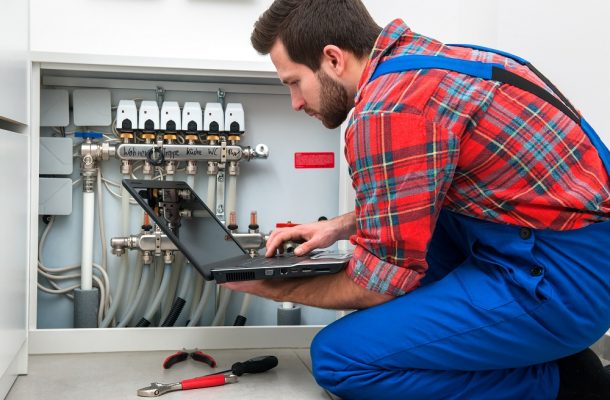
Peace Of Mind
A big question that you need to ask when you are working to improve your plumbing company for customers is whether you are giving them peace of mind. A major concern for customers is that they are going to be left out of pocket with your service. You need to show them that this won’t be the case. You can do this by ensuring that you have the right insurance coverage in place. That way if there is an issue that needs to be resolved you will be financially protected and so will your customers. Premiums can differ depending on the company that you choose so it is worth exploring a few different options here, before settling on the right one for your business.
Another way to provide peace of mind is to make sure that you are vetting and checking your team carefully. You need to ensure that there aren’t any red flags here in terms of safety and security. One of the best ways to do this is to use a recruitment manager. That way you can make sure that you only get the best people working in your business model. Don’t forget you can advertise that you have put these security measures in place and ensure that is a key point customers associate with your brand. You just need to guarantee that your customers feel secure when they choose your service and don’t end up double guessing themselves.
Transparency is another aspect to keep in mind here. Customers want to know exactly how much a plumbing solution is going to cost and that the price isn’t going to change in the long term. Often this is about ensuring that employees know how to interact with customers and ensure that they are being as clear as possible. While it’s important not to treat the clients as though they are stupid, team members will need to break down the jobs so they are easy to understand and make the cost as clear as possible.
Quality
Quality is a major factor that is always going to play into the reviews that you receive from customers. Are you delivering the level of quality that they expect from your company? If you’re not hitting the target here, then what can you do to change that? One thing to consider is the parts that you are using. Plumbing companies are always going to need to connect with a supplier to get the right parts. That’s true whether you’re fixing a valve or replacing a washer in a kitchen sink. It’s important that the parts you use are built to last. If you are worried about this, then you should check out the supplier you use carefully. Make sure to look at the reviews that they are receiving from other clients. Are they hitting the right marks? If not, then it’s worth shopping elsewhere even if it means paying a little extra.
Don’t forget that you also need to make sure that you can rely on the supplier to deliver the parts that you need on time. Customers aren’t likely to forgive you if they have to wait weeks or even months to get a crucial repair because you couldn’t source a key part for their system. Again, issues with turnaround time should be present if you check the reviews of the business in question.
The Right Price
Finally, it’s worth ensuring that you are providing your service at the right price to customers. If you don’t do this, then they are more likely to complain that they are either being ripped off or gouged by your company. You might think that with the economic situation the way it is, customers will forgive you for charging a higher price. However, this is not the case as they too are feeling the squeeze.
As such you need to make sure that you are checking the average costs on the market and make sure that you are matching them. If you can’t match them without putting your business under a considerable level of financial strain then you need to think about cutting costs in your company model. There are numerous ways that you can do this. For instance, you might want to think about using freelancers as part of your business team. The big benefit of freelancers is that you won’t have to provide them with any additional incentives as part of your business model. This is always going to make hiring them far more cost-effective.
Another way to cut the costs in your business model would be to go a little greener. You could have a fleet of vehicles as part of your plumbing company. It’s likely that you’ll be covering the cost of the fuel and while you can claim this as a tax deduction to an extent it could still be adding a lot of money to your budget. To deal with this, you should think about investing in hybrids. These are always going to provide a massive benefit and save you a large amount of money in the long term.
We hope this helps you understand the key improvements that you can make to deliver a better service to your clients. If you take these steps, you will be able to put your company in a far stronger position on the market and gain more support from a far larger customer base.

People have been spending a lot more time at home due to the covid pandemic, and even though things are beginning to level out a little, it still means there is more plumbing work to be done because people are using more water and heating their homes more often. However, due to the unfortunate amount Read more
People have been spending a lot more time at home due to the covid pandemic, and even though things are beginning to level out a little, it still means there is more plumbing work to be done because people are using more water and heating their homes more often. However, due to the unfortunate amount of people who have been put out of work due to covid, there are a lot more plumbers out there who have just started out and are eating into the sales of long term plumbers. There’s nothing wrong with this, it’s just business. But it does mean plumbers are looking for extra work. Here are some tips worth considering.
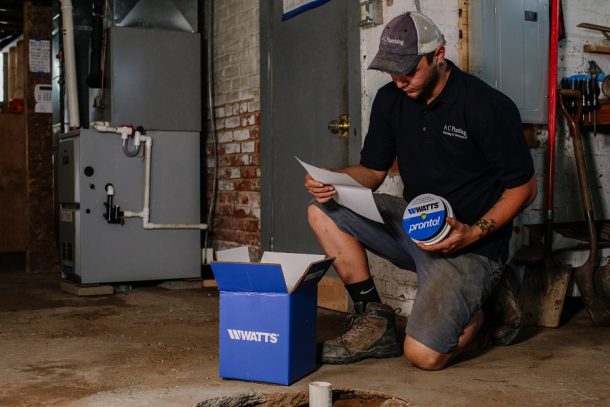
Check Professionalism Standards
This isn’t to say you aren’t professional. It’s just to reaffirm a couple of areas which you may want to pick up on. It doesn’t even concern the work you carry out (which will of course be to a high standard), or whether you’re using a tennant t7 or a titanium tubing cutter. It’s the simple things. Following up on a job with a text or email to ask how things are looking and whether the repair held or if it completely sorted the issue. This also builds on the chance of you receiving a positive review. Wearing shoe covers so you don’t walk mud through a home, keeping a mask on with regional regulations, etc. These little things are what can leave a big impact on a lot of people and lead them to recommending you to others. Keep them in mind and you’ll see more sales role in.
Use Social Media
So many people will search for tradespeople on social media these days instead of searching on Google or Bing. That’s how powerful social media has become. It’s why you really need to ensure you have a presence. Set up your business page with a powerful logo and your key business information including number, email address, or instant messaging facilities. It also provides a great platform for reviews. If they find you on Facebook, when you’ve completed the job you can ask for a review on Facebook which will again pull in more sales. It’s a great way of interacting with your local community.
Build Search Engine Visibility
Go to google and search for plumber in … (wherever you operate) and see what comes up. That’s where you need to be. On the first page, offering a free quotation, or no obligation quotation. How? You need a website, you can create one for free. You then need to build some useful content on your website. Being searchable is huge and will directly increase your sales. You can get help with this from SEO specialists but in reality you can do it yourself if you have the time so long as you can get some decent content on there. It also builds on the professionalism of you and your business. People do look for websites these days and having one will set you apart from those that don’t.

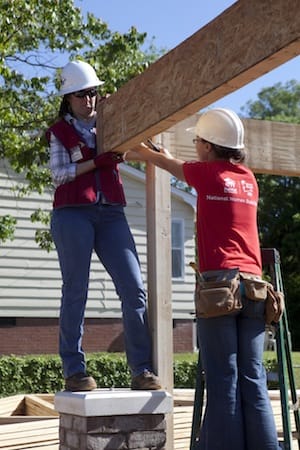 Mentors – Providing sage advice to apprentices and young people in the skilled trades helps them feel welcomed in their work environment. This extends to facilitating networking and social events.
Mentors – Providing sage advice to apprentices and young people in the skilled trades helps them feel welcomed in their work environment. This extends to facilitating networking and social events.